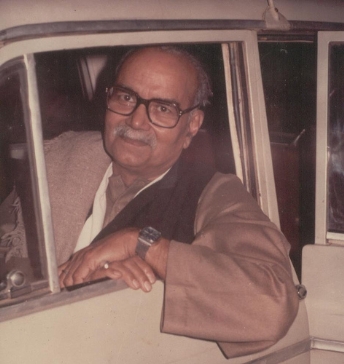
Prof. Rajendra Singh (29 January 1922 – 14 July 2003 ), popularly called Rajju Bhaiya, was the fourth Sarsanghchalak of the Rashtriya Swayamsevak Sangh (RSS). He was Sarsanghchalak between 1994 and 2000.
He worked as a professor and head of the Department of Physics at Allahabad University but left to devote his life to the RSS in the mid-1960s.
Rajendra Singh was born to Jwala Devi and Balbir Singh on 29 January in 1922 in Shahjahanpur city of Uttar Pradesh, when his father was posted there as an engineer. Originally his father Balbir Singh belonged to village Banail Pahasu of Bulandshahr district. Rajju Bhaiyya matriculated from Unnao. After that he was enrolled at the Modern School (New Delhi) for a brief period before moving to St Joseph’s College, Nainital. Progressing to Allahabad University, he obtained B.Sc. and M.Sc. degrees.
Rajju Bhaiyya was acknowledged as an exceptionally brilliant student by Sir C. V. Raman, the physicist and Nobel Prize-winner, when he was his examiner in M.Sc. He also offered Singh a fellowship for advanced research in nuclear physics. He joined Allahabad University after majoring in Physics to teach Spectroscopy. He taught at the university for several years, where later he was appointed head of the Physics Department.Rajju Bhaiyya was also considered an expert in nuclear physics which was very rare those days in India. He was a very popular teacher of the subject, using simplicity and clear concepts.
With RSS:
Singh was active in the Quit India Movement of 1942 and it was during this time that he came in contact with the RSS. From then onwards the Sangh influenced his life. He resigned from his university post in 1966 and offered full-time services to the RSS as a ‘prant pracharak’. Beginning in Uttar Pradesh, Singh progressed to be the Sar Karyavaha (General Secretary) in the 1980s. In 1994, he was nominated to succeed Bala Saheb Deoras as RSS chief.
While in Uttar Pradesh, Singh worked with Lal Bahadur Shastri, Chandra Shekhar and V.P. Singh. Murali Manohar Joshi was one of his best students.
Arguably Rajju Bhaiya’s term of six years was one of the most crucial for both Sangh and India. Rajju Bhaiyya shared an excellent rapport with political leaders cutting across ideological lines besides academicians, social workers and intellectuals.
He abdicated the post of Sarsanghchalak on account of his failing health in February 2000 and nominated Shri K. S. Sudarshan for the post.
During emergency he went underground and toured whole India. Singh was also responsible for organizing human rights convention presided by Justice VM Tarkunde in Delhi in 1976. He was also responsible for setting up friends of India Society International.
One of the most important beliefs of Singh was: “All people are basically nice. One should deal with every person by believing in his goodness. Anger, jealousy, etc. are the offshoots of his past experiences, which affect his behavior. Primarily every person is nice and everyone is reliable.”
Rajju Bhaiyya was a firm believer in the concept of swadeshi and empowering rural economy. Initiating the rural developmental activities, he had declared in 1995 that the utmost priority should be given in making the villages hunger-free, disease-free and educative. Today, there are over 100 villages where the rural development work done by swayamsevaks has inspired the people of surrounding villages and their experiments are being emulated by those people.
Addressing the Vijayadashami festival at Nagpur in 1995, Singh remembered Mohandas K. Gandhi and Lal Bahadur Shastri. He challenged the way in which the central governments till then were working on fulfilling the dreams of these two statesmen.
Rajju Bhaiyya wanted to establish a memorial named after Bismil in Delhi, the capital of India. He died on 14 July 2003 at Kaushik Ashram in Pune, Maharashtra.
(Source: www.rss.org)

More Stories
‘Tippu NijaSwarupam’ Book Launch event organised in Hyderabad
Muslim cleric from AP calls for assassination of PM Modi and Amit Shah
Kerala Church Rebels Against New Worship Method Mandated by Pope